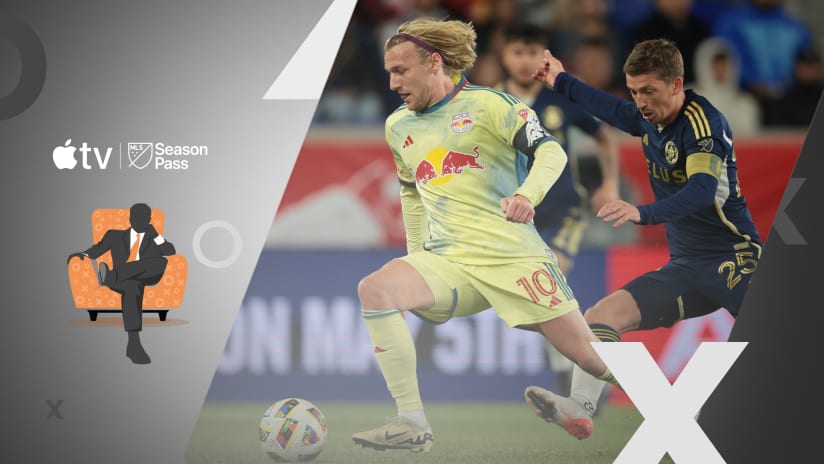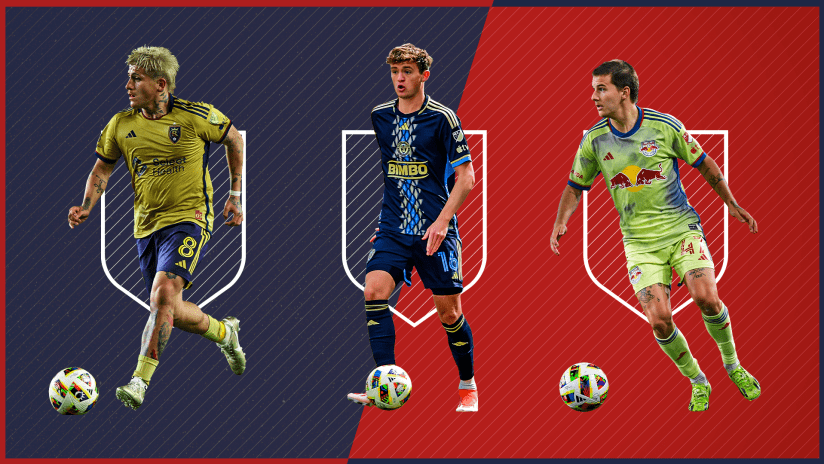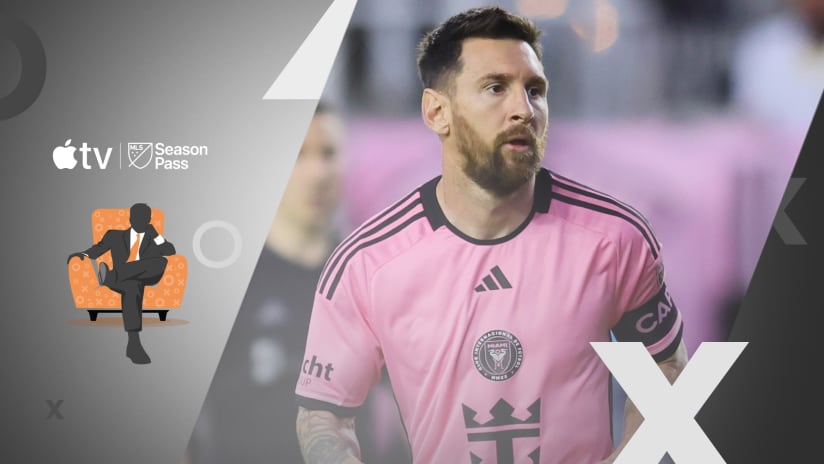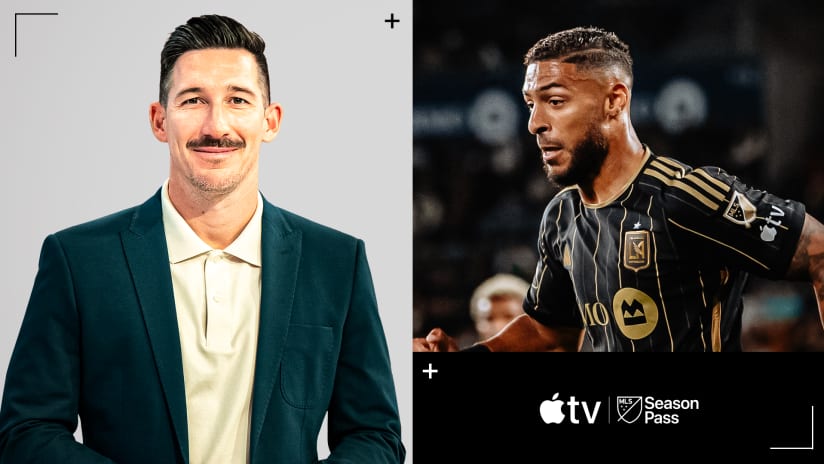We’re about three weeks away from “you are what your record says you are” territory, though I do think a couple of teams have gotten there already.
Let’s dive in:
It was a balmy 39 degrees in Quebec on Saturday evening as CF Montréal returned home for the first time in 2024. Despite an early injury to No. 9 Matías Cóccaro – the Uruguayan doesn’t generate a ton of highlights so nobody outside of Canada knows about him, but he’s so, so good on both sides of the ball – it proved to be a happy homecoming in three big ways:
- They won 2-1 over a very good FC Cincinnati side. Any would’ve been cause for celebration, but opening your home slate with a W over last year’s Supporters’ Shield winners? Magnifique.
- Josef Martínez replaced Cóccaro and got himself another goal. He’s now got 2g/3a in under 400 minutes, and has been lively in a way we haven’t seen from him since… 2019, maybe? I’m not saying King Josef is back, but he looks good.
- They did the sorts of stuff with the ball that we’d been waiting for, and that they’d only shown in flashes during their six-game odyssey to start the year.
Everyone understood why new manager Laurent Courtois took a more pragmatic approach during that road trip, but at the same time, we’ve all been eager for them to evolve. Part of it was that they just couldn’t play against the ball all the time and be successful – that was made clear during the final three games of the season-opening trip.
But a bigger part of it is that we all want to be entertained when we watch soccer, and Courtois comes from Columbus, who were the most entertaining team in the league last year.
Well, the evolution has arrived. Coming into this game Montréal were at 3.3 passes per sequence, which was in the bottom third of all MLS teams. On Saturday against a very good FC Cincinnati side, that number jumped to 3.9, which would be good for fourth in the league (just ahead of the Crew!).
They crested 50% possession for just the second time all year, outshot FC Cincinnati and, as per Sportec, doubled up the visitors’ xG total (other data services had it closer, but still). American Soccer Analysis’s g+ game flow model does a good job of capturing what happened:
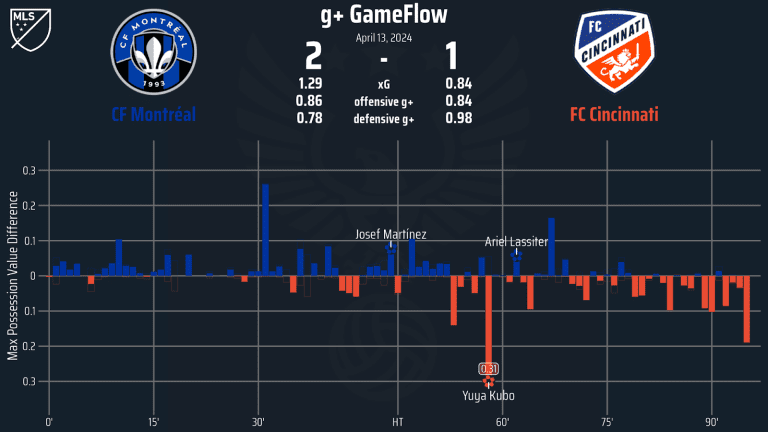
In short: Cincy didn’t generate consistent, sustained pressure until the game entered the Tactics Free Zone™ with 15 minutes left. And at that point, Montréal were good enough to hang onto the 2-1 final which they had earned in large part because of their movement on and off the ball.
“That was exactly what we had in mind. Playing a home game is certainly a factor, but we know what we do during the week and what we want to deliver on the pitch,” Courtois said afterward. “The whole thing is a puzzle that we piece together gradually. When one part doesn't fit, it's easy to call everything into question. Tonight, the whole group was up to standard. Everything was in its place. The final product is what we expected."
The first goal – Josef’s goal – is a great example of the final product Courtois is looking for:
Yes, this is a counterattack, but no, nobody’s in a hurry. And if you want to understand the catalyst for the type of possession soccer Courtois’ Crew 2 team played in MLS NEXT Pro, and the type of possession soccer he’s got his Montréal team pointed toward, there are two things you need to understand:
- The defenders want to be pressed. They want to invite opposing front lines and midfields to come upfield and pressure the ball, because they believe they will be able to pass through that pressure, find gaps between the lines and create chances.
- It is incumbent upon the central midfielders to understand that one always needs to be a vertical release valve during those sequences.
As the No. 10, Bryce Duke, drops deep to help in the build-out, the No. 8, Mathieu Choiniere, pushes forward to become an option between the lines. Duke knows this because he’s constantly scanning. You can see him check his shoulder in this still right here:
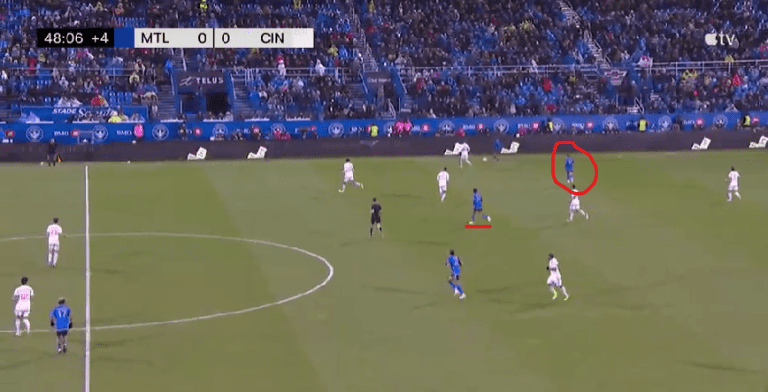
He sees Choinière and he knows there’s space between the lines. Execute that one-touch pass correctly, and it’s off to the races.
Courtois’ players are allowed to improvise to a degree, but it all comes from basic principles (be brave with the ball), structure (one safety valve square, one vertical outlet) and individual responsibility (map the field with constant scanning and hunting of space).
It’s awesome to see it come together so quickly.
Cincy are lacking that kind of chemistry, and there’s probably no better clip than the one above to illustrate it. Notice it starts with a potential 2-v-1 on the flank with Aaron Boupendza and Lucho Acosta? Yeah. Rather than keep the ball and give the play a chance to unfold, Boupendza skids a no-hoper to Yuya Kubo’s general vicinity. Lucho’s body language in that moment is… expressive.
The Garys are amid a mini three-game winless skid and play three of their next four on the road. I think they’ll probably come through it in ok shape, even with Roman Celentano sidelined via injury. But unless/until Boupendza starts living up to that DP tag, it’s hard to make an argument for this group being a top-tier team in the East.
Portland spent a lot of money last winter to bring in a centerpiece of a player that this next era could be built around.
For big chunks of time, that’s looked like a mistake. Evander has seemed either uninterested or, at times, unable to bend the game to his will. That’s not something you can ever say of the best No. 10s.
That inconsistent version of the Brazilian seems to have disappeared, and the new version has earned his turn in the spotlight. He’s become one of the best all-around No. 10s in the league, just a tank on the ball – a very creative tank – who looks dialed in for real.
That’s the good news. The bad news is that Portland, as a collective, look less so. Saturday’s 2-2 home draw against LAFC, which was colored significantly by Maxime Crépeau’s 48th-minute red card, ran their winless skid to five games. Over the past month they have conjured losses from what should have been draws, and last week conjured a draw that should’ve been a loss. This time, thanks to that red card, they conjured a draw from what should’ve been a win.
I’m gonna be optimistic and chalk that up as progress. Portland will need to start turning these performances into wins at some point, but luckily for the Timbers, the West is not exactly running away from them. They finished the weekend just below the playoff line and have more than 3/4s of the season remaining.
So where, besides Evander, does the optimism come from? Having a bit more structure in their build-out patterns is it:
All of that is very good, but the key is center back Miguel Araujo’s patience on the ball. When Juan Mosquera plays him that little back pass, Araujo changes his body shape as if to play back to his left, and in so doing shifts the entire LAFC front line.
At the same time the right winger, Antony, is checking back into the half-space to create an overload with Evander. That pins Denis Bouanga, who has to stay narrow and protect that pass.
And so you end up with an easy outlet to Mosquera, and the chance to combine against a back-pedaling defense. Good stuff.
Five minutes later it’s Mosquera attacking against a back-pedaling defense that leads to the game’s opening goal:
Notice, right at the start of the clip, Araujo telling Kamal Miller not to play backwards, but to hit that line-breaking pass to Mosquera? The Colombian’s got a runway to attack because Bouanga has run himself out of the play and didn’t recover to take away the passing lane. What took extra touches and patience five minutes earlier is now available via one pass because LAFC have been caught out pushing numbers forward.
Manager Phil Neville was understandably preoccupied with Crépeau’s red card in the postgame presser – I thought the call could’ve gone either way – but he did take a moment to praise his team’s mentality and his playmaker’s talent.
“I think we spoke three weeks ago about mentality. I think we showed a mentality today. I think there's a clear identity forming and I'm super proud with the way that they played,” Neville said. “And I think in Evander, I think we've got the best player in the conference at this moment in time. He's playing incredibly well.”
LAFC, meanwhile, continue their stop-start season. They’re now 3W-3L-2D and haven’t had the same result back-to-back yet.
I have banged on about their game model – how they’ve become too one-dimensional and reliant on transition, and how they struggle to create good chances when they’re forced to carry the game. I think that needs to change if they’re going to be the type of team that wins stuff.
The obvious rejoinder is that they’re creating a metric ton of chances anyway. We’re not talking about Bouanga being anonymous, right? We’re talking about him missing chances that a player of his caliber should bury. Same for Cristian Olivera. Mateusz Bogusz, meanwhile, had a brace on Saturday and seems to be doing more real No. 9 stuff. Olivera might not ever finish consistently, but Bouanga will. And if he’s next to a No. 9 that’s both creating danger and occasionally finishing plays off? Nobody will want to face that.
One-dimensional or not, the data says LAFC are still one of the best teams in the league. FBRef’s got the Black & Gold first in MLS in expected goal differential. American Soccer Analysis has them second in that stat, third in expected points, and sixth in their all-in-one goals added (g+) metric.
They are probably going to be fine once Bouanga snaps out of his slump. Probably.
12. And now I’ll turn it over to our chief correspondent, Calen Carr, for his weekly breakdown. He was on the banks of the mighty Passaic for a scoreless draw between the Red Bulls and visiting Chicago Fire:
The Red Bulls had 60% possession until the red card changed the entire complexion of the match. Andrés Reyes was having a strong match, but too often stands out for the wrong reasons. His red card away from the ball was obvious.
Chicago looked uncomfortable as protagonists and created very few opportunities with over an hour of having a man advantage. Xherdan Shaqiri was active early but faded as the game went on when they needed more from him. The few moments when Red Bull were caught out he took too many touches and played backwards, including getting caught on the ball for what turned into Red Bull hitting both posts in the same sequence.
Frank Klopas told me during the week that they had left points on the board this season and were looking for opportunities to win them back. This match set up well for that, but they lacked ideas to break down a compact Red Bull side that responded better to the changes of the match.
11. Federico Bernardeschi giveth (he played a role in both TFC goals), and Federico Bernardeschi taketh away. This isn’t all – or even mostly – on the Italian DP, but man, the one thing you can not do here is let Jaylin Lindsey turn and play directly to Brecht Dejaegere’s feet:
That was the winner for Charlotte in their 3-2 win over the visiting Reds. To dive in a little further on that play: there is no way Dejaegere (or really anyone) should ever be that wide open in that spot on the field coming off a set piece with the game on the line. Bernardeschi’s inattention to detail in his body shape while pressing Lindsey wouldn’t have come back to bite TFC if the folks behind him had taken care of business.
But those sorts of breakdowns are happening more or less weekly now for the Reds. They didn’t for the first few matchdays of the season. And what we’ve seen so far confirms everyone’s suspicions entering the season: this team’s not good enough to survive shootouts.
The Crown weren’t great but they were dangerous, and got themselves two more goals from their wingers, including one from new DP Liel Abada. They have been opportunistic and organized, and one of the guiding principles under Dean Smith seems to have become “get multiple runners into the box as often as possible.”
It’s simple, but simple is good. Simple works.
10. It’s probably not a surprise that Orlando City got Wilder Cartagena and César Araújo both healthy and available in deep central midfield and suddenly looked pretty good and very dangerous in what became a 3-2 win at D.C. United.
Now, I’m not going to say they were consistently both things – the first half was good and the final 15 minutes were great, and in between Orlando basically didn’t come out of the locker room to start the second half – but given the way things had been going, putting out a promising 60 minutes on the road and coming away with three points qualifies Saturday as maybe the best day of the year for the purple Lions.
Baked into the result was some experimentation from Oscar Pareja, who started Facu Torres as a No. 10 and Martín Ojeda as an inverted right winger in their standard 4-2-3-1.
I don’t understand why those positions aren’t reversed. Torres was mostly invisible from open play, and always looked uncomfortable when pushed central and asked to run the show.
Still, a result is a result.
“I thought, first half, we played better, we had some options and in the second half they gave us a little trouble there with the style,” Pareja said in the postgame. “But, as I said, we solved it and we found our ways to score, which is fantastic for our team at this moment. The most important thing is the heart that the players showed today. They have done it before, but not with results, but we got a result and that’s important for us in this moment.”
D.C. need to start turning some of these performances into results. For all the promise they’ve shown – and it’s been a lot – they are developing a habit of coughing up leads and leaving points on the table. And now they’ve taken just one win from their past seven.
9. NYCFC took care of business at home with a dominant 2-0 win over the visiting Revs, a score which pretty accurately reflected the run of play. Keaton Parks was a one-man field tilt machine, and so the Pigeons’ young attackers got plenty of chances on the ball in the most valuable spots on the field.
There’s 80% of the season left to play and the Revs are just six points back of the final playoff spots in the East, so nobody should be throwing in the towel. But they’ve not shown anything all year that suggests they’re about to turn this thing around, and DeJuan Jones coming off injured 26 minutes into this one just makes the hole they’re in deeper.
8. The same, I think, would be said for FC Dallas. They at least got themselves a home point thanks to a scoreless draw with the Sounders, but they really only generated one good look – Sebastian Lletget’s 53rd-minute header that he flashed wide.
Dallas just don’t move the ball quickly or incisively through midfield, which means they’re not dangerous unless they’re taking wild risks sending numbers forward, except they’re not particularly secure on the ball in those situations, which means they’re way more prone to costly turnovers that lead to goals against because they’re taking huge risks sending numbers forward.
It’s a vicious cycle.
“The decisions,” head coach Nico Estévez said afterward. “In the first half, most of the situations we had, they were open to shoot and they would pass. And then in the second half, most of the situations they should have passed, and then we shot.”
The Sounders are also caught somewhere in the same vicious cycle, though I’m willing to chalk their issue up more to wayward finishing than anything structural. Next week against the Whitecaps feels big, though.
7. Speaking of the ‘Caps, they were able to create constant danger against the visiting Galaxy but still got drilled 3-1 at home, which was not a great way to finish a four-game homestand.
Vancouver take a lot of risks with the positioning of their wingbacks, who are playing wider and much, much higher than last year. And I will say that on the day, from a tactical perspective, those risks made sense since the ‘Caps created chance after chance after chance and, for most of the game, the Galaxy were only dangerous on the break or when taking wild risks of their own (right-side overloads with both Joseph Paintsil and Gabriel Pec, anyone?).
And then almost out of nowhere, the Galaxy painted an absolute masterpiece:
Vanni Sartini, as is his habit, gave a banger of a postgame presser.
“We have to do the things we are supposed to do, we have to mark the space and not roam around and press and man-mark and concede that second goal. That is totally my fault because when the team doesn’t do what they’re supposed to do, it’s my fault at the end and we need to work at it,” Sartini said. “But it’s a knife to my heart, it really is because it’s the worst way to lose, because it’s all our fault. We need to know it’s all our fault. Because if we are two, three minutes just a little bit more patient, and we defend well, we win. Not draw, we win, and I’m so pissed about it because of that.”
The Galaxy, as is their weekly habit, conceded a set-piece goal. This was a great win for them, but if they remain brutally bad defending restarts, there’s a hard cap on how high they can climb.
6. It was a throwback Dynamo performance in Minnesota, as they visited the Loons and suffered for 90 minutes before coming away with a 2-1 win that, man… it’s hard to say they deserved it, but they sure did earn it.
This goal-line clearance is absurd:
Houston have won four of five, and finished the weekend tied for second in the West on 13 points despite playing more or less the entire season thus far with zero DPs. If the Coach of the Year vote was held right now, Ben Olsen should win it unanimously.
The Loons should be pissed about the loss, but happy with how they played. Run this out every week and you’ll win many, many more than you lose.
We’ll see what happens with Emanuel Reynoso in the coming weeks, I’m sure.
5. RSL should feel the same way, as they were able to create a constant stream of decent-ish chances against a heavily rotated Columbus squad, but very few clear-cut chances and subsequently finished with a scoreless draw.
I found this to be a particularly frustrating and somewhat emblematic sequence of play:
They do so well to pull Columbus side-to-side and create the easy outlet to build up the right side, but Andrés Gómez takes an extra touch instead of playing square directly into Emeka Eneli’s run. And instead of a chance for the home side, they have to scramble to cut off a Crew counterattack.
If RSL are going to climb into contention with the best teams in the league – like the full-strength Crew – they’re going to have to be better in those build-out situations.
This was a very nice point for Columbus, especially with 18-year-old homegrown playmaker Taha Habroune getting his debut.
4. Colorado went to San Jose and thrashed the Quakes, posting a 3-0 final behind a brace from Rafa Navarro and a late capper from Cole Bassett. It was the first road win by three or more goals for the Rapids since September 2020, which feels like a million years ago.
Colorado’s first goal came from their press (which resulted in a Navarro PK), and their second came off a long throw (which resulted in Navarro’s first run-of-play goal in Burgundy), and their third came from their counter-press. In a way, it was the most Red Bulls-y performance of the year under new head coach Chris Armas – pressing and set pieces, folks – but as I’ve written, and said on both This is MLS and Extratime, this team actually isn’t doing a ton of Energy Drink Soccer stuff.
Armas has them keeping the ball more than just a little bit. They’re very happy to build from the back and are in no rush to just boot it: only 34% of their passes are forward (that’s 20th in the league) and only 11.8% of their passes are long balls (that’s 16th). They have been solid and versatile.
The Quakes continue to be somewhat promising in the attack, but their defense and goalkeeping have been a disaster all year long. They have one win and seven losses in eight games and are about to play four of their next five on the road.
I tweeted out on Saturday night that this felt like rock bottom, but that might’ve been premature.
3. MLS After Dark arrived on Sunday afternoon as Atlanta spent the first 25 minutes of the second half building what looked like an insurmountable 2-0 lead on the visiting Union, then the final 20 minutes blowing it in what became a 2-2 draw.
I’m gonna bullet-point some thoughts from this one:
- Thiago Almada had probably his best game of the year in terms of chance creation. He’d looked weirdly disjointed the past two months.
- The opening goal is exactly why Atlanta’s front office went out and got Daniel Ríos.
- Atlanta feel a lot like the Galaxy – a dynamic possession/attacking team who are not solid enough defensively to be elite.
- Andre Blake might just need some time off. Hope he’s ok.
- Philly are soft and more prone to losing individual battles at the back than any time in recent memory, yet…
- They are resilient enough overall to turn losses into draws and draws into wins.
In the end, Philly remain the final unbeaten team in MLS. But man, it doesn’t feel like it. Maybe I’m just grumpy, but I left this game with both teams' flaws screaming louder than their virtues.
2. Our Face of the Week goes to João Klauss, who got the winner in St. Louis’s 1-0 win over visiting Austin:
Steve Cangialosi and Danny Higginbotham say it all in the commentary: it’s his first goal from the run of play since September 2023, so it’s been a long time coming. You can see the frustration give way to relief on his face.
The game was about exactly what you’d have thought: St. Louis had clear pressing triggers and Austin mostly just tried to survive, but didn’t have the attacking quality to turn their few good moments into actual danger. The only real question was whether CITY would find a winner or just paint the woodwork again.
1. And finally our Pass of the Week goes to Lionel Messi because c’mon:
This pass is so good even Luis Suárez – a genius who is one of the greatest strikers of all-time – doesn’t see it. Notice how he takes an extra beat before reacting? Yeah.
Anyway, we saw all the things in this game that suggest Miami (who are technically top of the table) are among the favorites to win the Shield: Messi being Messi, Suárez being Suárez, great off-ball work from Diego Gómez and secondary chance creation from Julian Gressel, etc.
We also saw all the stuff that says they’re still very much a work in progress: a disorganized backline (new right back Marcelo Weigandt has not covered himself in glory thus far), a midfield that can’t recover when they lose the ball, and center backs who maybe aren’t good enough with their distribution to make the side truly dominant in the way they need to be in order to pitch consistent shutouts.
I’m still not picking against Messi – I think they’ll figure enough stuff out to win the Shield. But the flaws are glaring at the moment.
The same is obviously true of Sporting KC, who more or less gifted the visitors the win with some questionable decisions playing out of the back. I know the plan was to wait until summer to make a move for a DP No. 10, but man, that feels a long way off and this team pretty clearly needs help on both sides of the ball right now.



